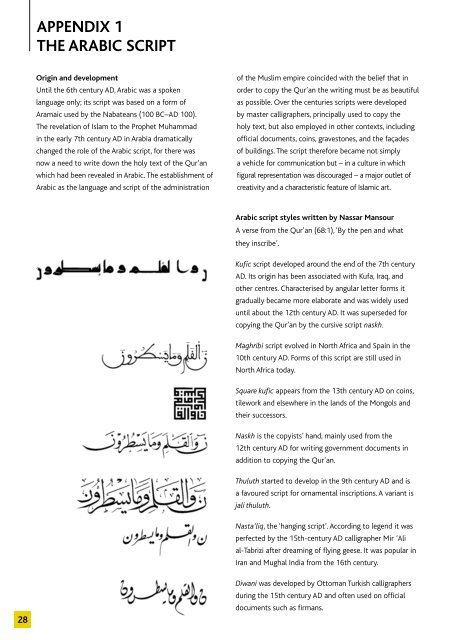You also want an ePaper? Increase the reach of your titles
YUMPU automatically turns print PDFs into web optimized ePapers that Google loves.
APPENDIX 1<br />
THE <strong>ARAB</strong>IC SCRIPT<br />
Origin and development<br />
Until the 6th century AD, Arabic was a spoken<br />
language only; its script was based on a form of<br />
Aramaic used by the Nabateans (100 BC–AD 100).<br />
The revelation of Islam to the Prophet Muhammad<br />
in the early 7th century AD in Arabia dramatically<br />
changed the role of the Arabic script, for there was<br />
now a need to write down the holy text of the Qur’an<br />
which had been revealed in Arabic. The establishment of<br />
Arabic as the language and script of the administration<br />
of the Muslim empire coincided with the belief that in<br />
order to copy the Qur’an the writing must be as beautiful<br />
as possible. Over the centuries scripts were developed<br />
by master calligraphers, principally used to copy the<br />
holy text, but also employed in other contexts, including<br />
official documents, coins, gravestones, and the façades<br />
of buildings. The script therefore became not simply<br />
a vehicle for communication but – in a culture in which<br />
figural representation was discouraged – a major outlet of<br />
creativity and a characteristic feature of Islamic art.<br />
Arabic script styles written by Nassar Mansour<br />
A verse from the Qur’an (68:1), ‘By the pen and what<br />
they inscribe’.<br />
Kufic script developed around the end of the 7th century<br />
AD. Its origin has been associated with Kufa, Iraq, and<br />
other centres. Characterised by angular letter forms it<br />
gradually became more elaborate and was widely used<br />
until about the 12th century AD. It was superseded for<br />
copying the Qur’an by the cursive script naskh.<br />
Maghribi script evolved in North Africa and Spain in the<br />
10th century AD. Forms of this script are still used in<br />
North Africa today.<br />
Square kufic appears from the 13th century AD on coins,<br />
tilework and elsewhere in the lands of the Mongols and<br />
their successors.<br />
Naskh is the copyists’ hand, mainly used from the<br />
12th century AD for writing government documents in<br />
addition to copying the Qur’an.<br />
Thuluth started to develop in the 9th century AD and is<br />
a favoured script for ornamental inscriptions. A variant is<br />
jali thuluth.<br />
Nasta‘liq, the ‘hanging script’. According to legend it was<br />
perfected by the 15th-century AD calligrapher Mir ‘Ali<br />
al-Tabrizi after dreaming of flying geese. It was popular in<br />
Iran and Mughal India from the 16th century.<br />
Diwani was developed by Ottoman Turkish calligraphers<br />
during the 15th century AD and often used on official<br />
The Arabic Alphabet in Naskh script<br />
written by Mustafa Ja’far<br />
The Arabic alphabet is written from right to left<br />
(shown vertically here with Latin equivalents) and<br />
consists of 28 letters created from 17 different letter<br />
shapes. In modern Arabic dots above and below help<br />
to distinguish letters from each other. In early Arabic<br />
these dots were frequently omitted. Many of the<br />
letters change their shape depending on where they<br />
are situated within a word. These variations are shown<br />
here alongside the individual letters. The letters that<br />
are underlined are pronounced emphatically. The Arabic<br />
alphabet has been employed and developed to write a<br />
variety of other languages. One of these is Persian which<br />
has 32 letters. To accommodate the extra sounds four<br />
Arabic letters have been adapted as follows:<br />
g z ch p<br />
documents such as firmans.<br />
28 29<br />
a<br />
b<br />
t<br />
th<br />
j<br />
h<br />
kh<br />
d<br />
dh<br />
r<br />
z<br />
s<br />
sh<br />
s<br />
d<br />
t<br />
z<br />
ayn<br />
gh<br />
f<br />
q<br />
k<br />
l<br />
m<br />
n<br />
h<br />
w<br />
y

















